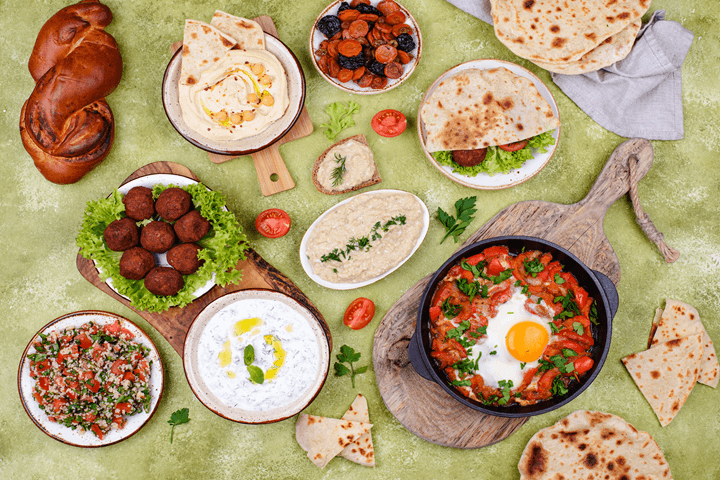Middle Eastern food is renowned for its vibrant flavors, aromatic spices, and a rich history spanning centuries. It’s a culinary tradition deeply rooted in fresh, wholesome ingredients, making much of it naturally healthy Arabic food. However, some beloved dishes can be prepared in ways that increase their fat or calorie content. This article will show you easy and practical ways to make your favorite healthy Middle Eastern food even healthier. It will allo you to indulge in the deliciousness without compromising your well-being.
Why is Healthy Middle Eastern Food So Good for You?
The core principles of Arabic cuisine naturally align with many modern dietary recommendations, often mirroring the benefits of the Mediterranean diet.
- Abundance of Fresh Produce: Healthy Middle Eastern food champions a wide array of fresh vegetables. A few examples are tomatoes, cucumbers, eggplant, zucchini, and leafy greens, along with fruits like dates, figs, and pomegranates. These are packed with vitamins, minerals, and fiber.
- Power of Legumes: Chickpeas (hummus, falafel), lentils (soups, mujadara), and fava beans are staples. These provide excellent sources of plant-based protein, fiber, and essential micronutrients.
- Whole Grains: Bulgur, freekeh, and whole wheat bread are commonly used, offering complex carbohydrates for sustained energy and good digestive health.
- Heart-Healthy Fats: Olive oil is a cornerstone of healthy Arabic food, rich in monounsaturated fats and antioxidants beneficial for heart health. Nuts and seeds also contribute healthy fats and nutrients.
- Lean Proteins: Grilling and roasting lean cuts of chicken, fish, and sometimes lamb, are preferred cooking methods for protein sources in many dishes.
- Flavor from Herbs and Spices: Healthy Middle Eastern food relies heavily on fresh herbs like parsley, mint, and cilantro, and a vibrant array of spices like cumin, coriander, turmeric, and sumac. These not only enhance flavor but also offer anti-inflammatory and other health benefits.
Simple Swaps for Even Healthier Middle Eastern Food
Making your favorite dishes even healthier often involves small, smart adjustments.
- Bake, Don’t Fry: Many fried favorites, like falafel (فلافل) and sambousek (سمبوسك), can be easily baked or air-fried for a significantly lower fat content without sacrificing crispiness.
- Go Lean on Meats: Opt for leaner cuts of lamb or chicken breast. If a recipe calls for minced meat, consider reducing the quantity and supplementing with lentils or chickpeas. Remove skin from poultry before cooking.
- Mind Your Oils: While olive oil is healthy, excessive amounts can add calories. Be mindful of drizzles and cooking quantities. Use non-stick pans or olive oil sprays for lighter cooking.
- Embrace Whole Grains: Whenever possible, choose whole wheat pita bread (خبز قمح كامل) over white, or swap white rice for brown rice (أرز أسمر), quinoa (كينوا), bulgur (برغل), or freekeh (فريكة) in pilafs and accompanying dishes.
- Sweeten Naturally & Moderately: Traditional Arabic sweets can be very rich. Enjoy them in moderation or opt for naturally sweet fruits like dates and figs for dessert. If making at home, consider using natural sweeteners like honey or date syrup sparingly instead of refined sugar.
- Reduce Salt: Many pickled items or preserved foods can be high in salt. If preparing at home, control salt levels, and consider rinsing pickled vegetables before serving to reduce their sodium content.
- Boost the Veggies: Naturally, healthy Middle Eastern food includes lots of vegetables. Don’t be shy about adding extra fresh vegetables to stews, salads, and wraps. For dips like hummus or baba ghanoush, pair them with abundant fresh vegetable sticks instead of relying solely on bread.
Delicious Examples of Naturally Healthy Arabic Food
Many classic Arabic cuisine food items are already powerhouses of nutrition.
- Tabbouleh (تبولة): A refreshing salad packed with parsley, tomatoes, bulgur, lemon juice, and olive oil – high in fiber and vitamins.
- Hummus (حمص): A creamy dip made from chickpeas, tahini, lemon juice, and garlic, offering excellent protein and fiber.
- Fattoush (فتوش): A vibrant mixed green salad with fresh vegetables, herbs, and toasted (or lightly baked) pita pieces, dressed with sumac and olive oil.
- Lentil Soup (شوربة عدس): A comforting and protein-rich soup, often seasoned with cumin and lemon.
- Grilled Kebabs (كباب مشوي): Opt for lean chicken or lamb kebabs, grilled to perfection, providing lean protein.
- Baba Ghanoush (بابا غنوج): A smoky eggplant dip that’s low in calories and rich in fiber and antioxidants.
- Stuffed Vegetables (محاشي): Dishes like stuffed bell peppers or zucchini, especially when filled with rice and herbs, are nutritious. Opt for vegetable-based fillings to maximize health benefits.
- Labneh (لبنة): A strained yogurt cheese, high in protein and probiotics, perfect with a drizzle of olive oil.
Conclusion: A Wholesome and Flavorful Experience Awaits
The journey through Middle Eastern food is an exciting one, offering incredible flavors and diverse textures. By applying these simple tips, you can ensure that your culinary adventures are not only delicious but also contribute to a healthy lifestyle. Embrace the rich array of ingredients, traditional cooking methods, and vibrant spices that define healthy Arabic food, and savor every wholesome bite!
Ready to embark on a flavorful and healthy journey through Arab cuisine? Download the Kaleela app today and learn the Arabic names of these delicious and nutritious foods!




